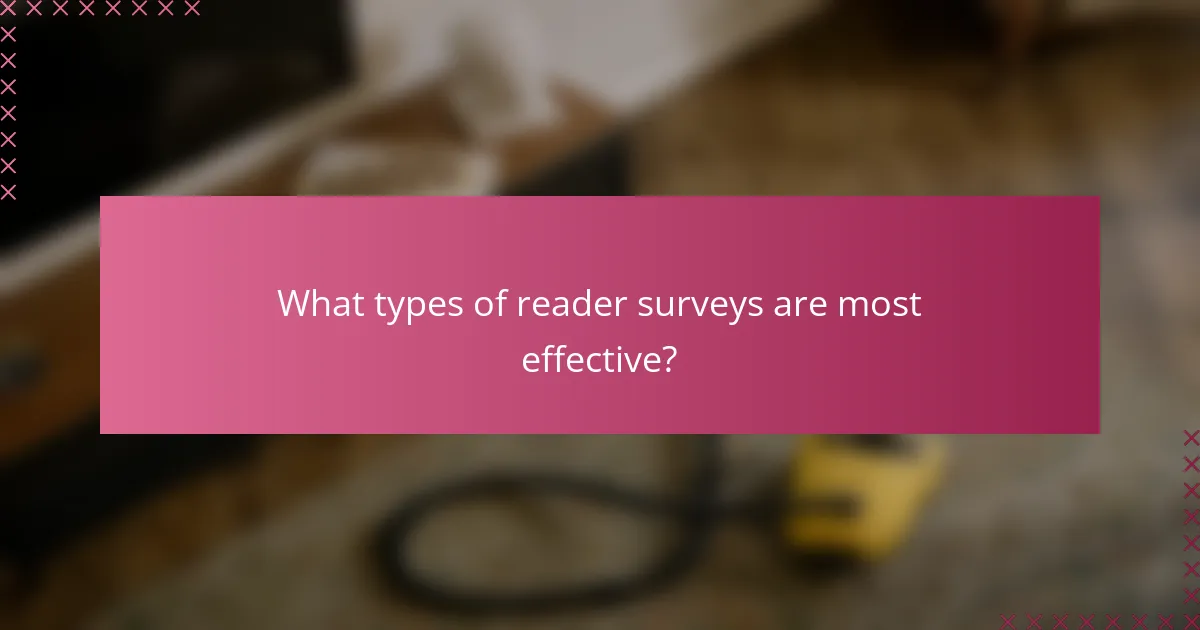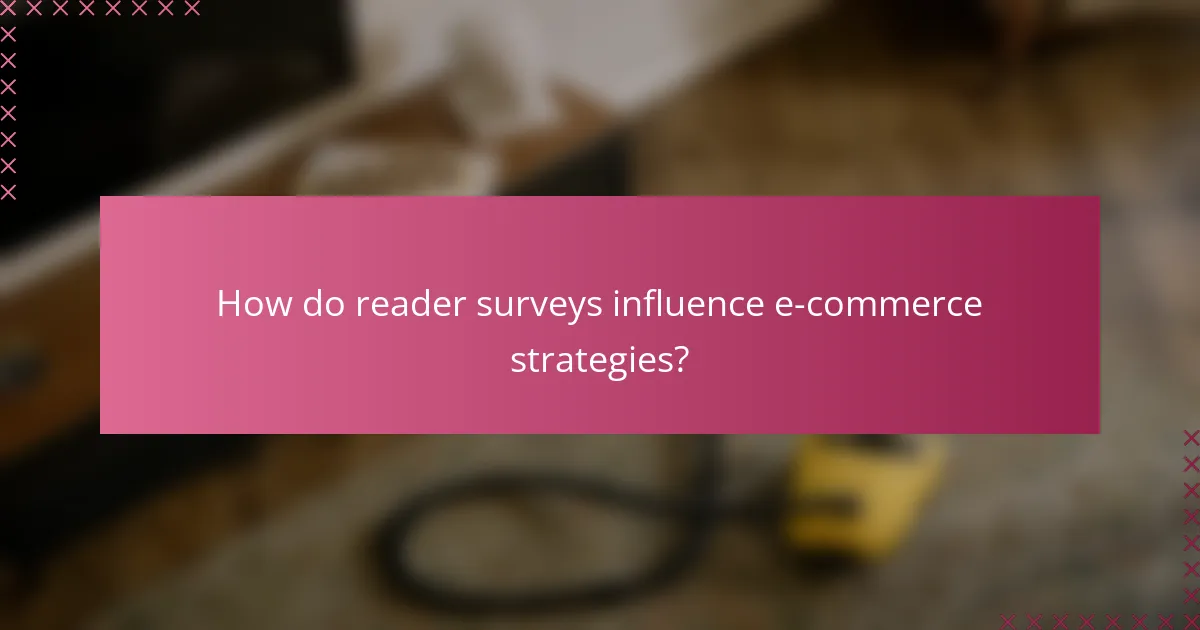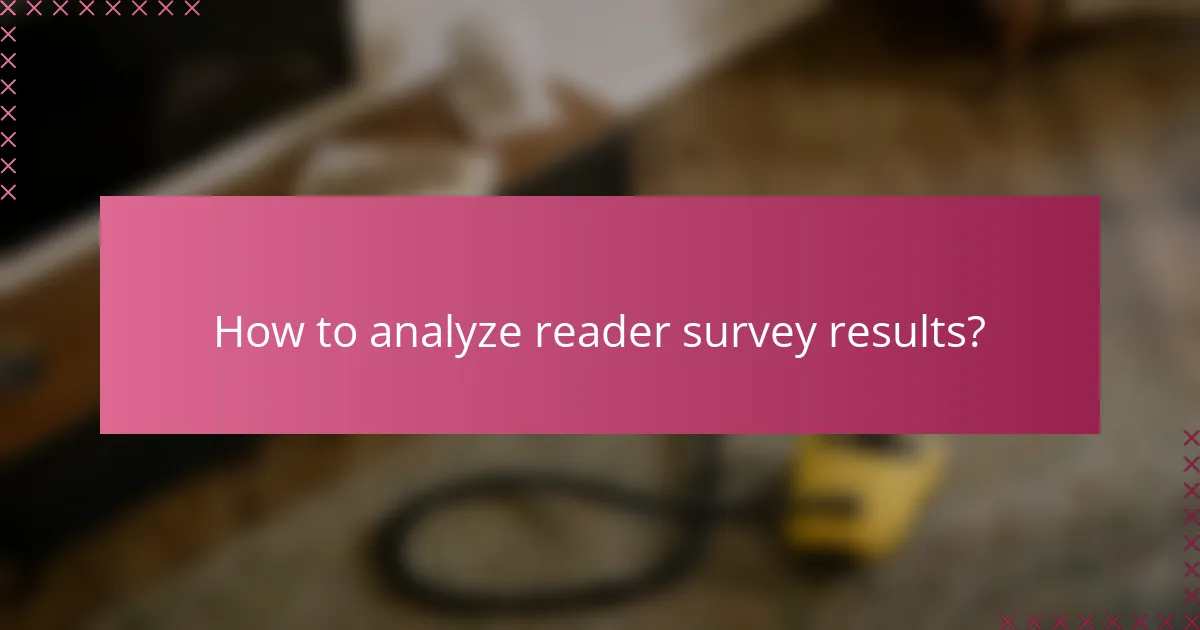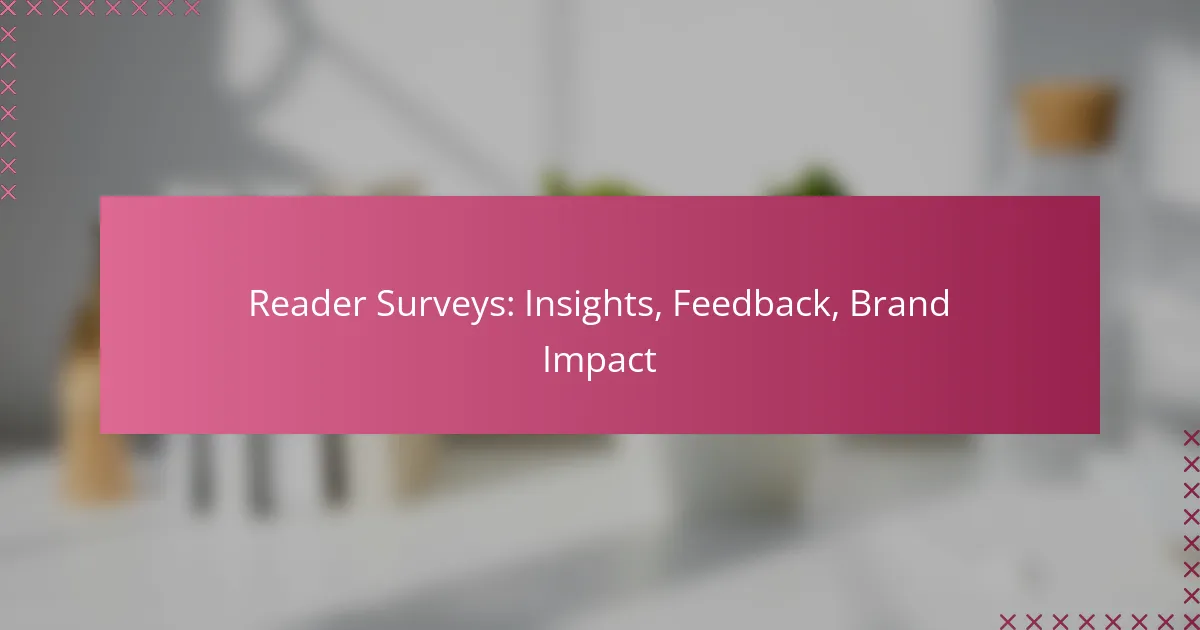Reader surveys play a crucial role in enhancing brand impact by collecting valuable insights from the audience. By understanding customer preferences and feedback, brands can improve engagement and tailor their offerings to better meet market demands.

How can reader surveys improve brand impact?
Reader surveys can significantly enhance brand impact by gathering valuable insights directly from the audience. This feedback helps brands understand customer preferences, improve engagement, and tailor their offerings to meet market demands.
Enhanced customer engagement
Reader surveys foster enhanced customer engagement by encouraging direct communication between brands and their audience. When customers feel their opinions are valued, they are more likely to interact with the brand, leading to increased participation in future surveys and promotions.
To maximize engagement, brands should ensure surveys are concise and relevant. Offering incentives, such as discounts or exclusive content, can also motivate customers to participate and share their thoughts.
Informed product development
Surveys provide critical data that informs product development, allowing brands to align their offerings with customer needs. By analyzing survey responses, companies can identify gaps in the market and adjust their product features or services accordingly.
For effective product development, brands should focus on specific questions that reveal customer pain points and preferences. Regularly conducting surveys ensures that product adjustments remain relevant and timely, ultimately leading to better market fit.
Increased customer loyalty
Implementing insights from reader surveys can lead to increased customer loyalty. When customers see that their feedback results in tangible changes, they are more likely to develop a strong connection with the brand.
To cultivate loyalty, brands should communicate how customer feedback has influenced decisions. Regular follow-ups and updates can reinforce the message that customer opinions are integral to the brand’s evolution, fostering a sense of partnership and trust.

What types of reader surveys are most effective?
The most effective reader surveys typically include online questionnaires, focus groups, and feedback forms. Each method has unique strengths and can provide valuable insights into reader preferences and experiences.
Online questionnaires
Online questionnaires are a popular choice for gathering reader feedback due to their convenience and scalability. They can reach a wide audience quickly and can be designed to collect both quantitative and qualitative data through various question formats.
When creating online questionnaires, consider keeping them concise to encourage higher completion rates. Aim for a mix of multiple-choice questions and open-ended responses to capture a range of insights. Tools like Google Forms or SurveyMonkey can facilitate easy distribution and analysis.
Focus groups
Focus groups involve small groups of readers discussing their opinions and experiences in a guided setting. This qualitative method allows for deeper exploration of reader sentiments and can reveal insights that surveys might miss.
To conduct effective focus groups, select participants that represent your target audience and prepare open-ended questions that encourage discussion. Sessions should be moderated to ensure all voices are heard and to keep the conversation on track. Typically, groups of 6-10 participants work best for this format.
Feedback forms
Feedback forms are often integrated into websites or publications, allowing readers to provide input at their convenience. These forms can be simple and straightforward, focusing on specific aspects of the reader’s experience.
To maximize the effectiveness of feedback forms, keep them short and focused on key areas such as content quality, usability, and overall satisfaction. Providing an incentive, like entry into a prize draw, can also encourage more readers to share their thoughts. Regularly reviewing and acting on this feedback is crucial for continuous improvement.

What are the best practices for conducting reader surveys?
Effective reader surveys are designed to gather actionable insights while ensuring a positive experience for participants. Best practices include crafting clear questions, selecting the right audience, and offering incentives to encourage participation.
Clear and concise questions
Questions should be straightforward and easy to understand, avoiding jargon and ambiguity. Aim for a mix of open-ended and closed questions to gather both qualitative and quantitative data. For instance, instead of asking, “How do you feel about our content?” consider “What topics would you like to see more of?”
Limit the number of questions to keep the survey manageable, ideally between 5 to 10 questions. This helps maintain participant engagement and increases the likelihood of completion.
Targeted audience selection
Selecting the right audience is crucial for obtaining relevant feedback. Identify your target demographic based on factors such as age, interests, and reading habits. This ensures that the insights gathered are representative of your actual readership.
Utilize existing subscriber lists or social media followers to reach your audience. Consider segmenting your audience further to tailor questions that resonate with specific groups, enhancing the quality of the feedback received.
Incentives for participation
Offering incentives can significantly boost response rates. Consider providing small rewards, such as discount codes, gift cards, or exclusive content, to encourage participation. Clearly communicate these incentives in your survey invitation to attract more respondents.
Ensure that the value of the incentive aligns with your audience’s interests. For example, if your readers are primarily students, a gift card to a popular bookstore may be more appealing than a generic prize. This approach can lead to higher engagement and more meaningful insights.

How do reader surveys influence e-commerce strategies?
Reader surveys significantly shape e-commerce strategies by providing insights into customer preferences and behaviors. These insights help businesses tailor their marketing efforts, enhance customer experiences, and manage inventory more effectively.
Data-driven marketing decisions
Data from reader surveys allows e-commerce businesses to make informed marketing decisions based on actual customer feedback. By analyzing survey results, companies can identify trends, preferences, and pain points, which can guide advertising strategies and promotional campaigns.
For instance, if a survey reveals that customers prefer eco-friendly products, a brand can adjust its marketing focus to highlight sustainable offerings. This targeted approach often leads to higher engagement and conversion rates.
Personalized customer experiences
Surveys enable e-commerce platforms to create personalized experiences by understanding individual customer needs. By segmenting survey responses, businesses can tailor their website content, product recommendations, and email marketing to resonate with specific customer groups.
For example, if a survey indicates that a segment of customers values fast shipping, the e-commerce site can prioritize those options for that group, enhancing satisfaction and loyalty. Personalization can lead to increased sales and repeat business.
Optimized inventory management
Reader surveys can help e-commerce companies optimize their inventory management by revealing customer demand patterns. Understanding what products are in demand allows businesses to adjust their stock levels accordingly, reducing excess inventory and minimizing stockouts.
For instance, if survey data shows a growing interest in a particular product category, a retailer can increase orders to meet anticipated demand. This proactive approach ensures that the right products are available at the right time, improving overall operational efficiency.

What tools can be used for reader surveys?
Reader surveys can be effectively conducted using various online tools that simplify the process of gathering feedback. These tools allow you to create customized surveys, distribute them easily, and analyze the results efficiently.
SurveyMonkey
SurveyMonkey is a widely used platform for creating surveys with a user-friendly interface. It offers a variety of templates and question types, making it easy to tailor your survey to specific needs. Consider using its analytics features to gain insights into reader responses and trends.
When using SurveyMonkey, be mindful of the pricing tiers. The free version has limitations on the number of questions and responses, while paid plans provide more advanced features. Aim for clarity in your questions to avoid confusion and ensure quality feedback.
Google Forms
Google Forms is a free tool that integrates seamlessly with other Google services, making it a convenient option for many users. It allows for easy customization and real-time collaboration, which is beneficial if multiple team members are involved in survey creation.
One advantage of Google Forms is its unlimited response collection, which is ideal for larger audiences. However, it may lack some advanced analytics features found in paid survey tools, so consider exporting the data to Google Sheets for further analysis.
Typeform
Typeform stands out for its visually appealing and interactive survey design. It focuses on user experience, which can lead to higher completion rates. The platform supports various question formats, including multiple choice, short answer, and rating scales.
While Typeform offers a free version, its more advanced features require a subscription. To maximize engagement, keep surveys concise and ensure that questions flow logically. This can help maintain reader interest and yield better quality responses.

How to analyze reader survey results?
Analyzing reader survey results involves systematically reviewing feedback to extract actionable insights. This process helps identify trends, preferences, and areas for improvement, ultimately enhancing reader engagement and brand impact.
Identify key metrics
Start by determining which metrics are most relevant to your goals. Common metrics include overall satisfaction, Net Promoter Score (NPS), and specific feedback on content quality or relevance. Prioritize metrics that align with your brand objectives.
For example, if your goal is to increase reader loyalty, focus on NPS and satisfaction ratings. This will help you gauge how likely readers are to recommend your content to others.
Segment your audience
Segmenting your audience allows for a more nuanced analysis of survey results. Consider demographics, reading habits, or engagement levels to identify patterns within different groups. This approach can reveal specific preferences or pain points among various reader segments.
For instance, younger readers might prefer shorter articles, while older demographics may appreciate in-depth analysis. Tailoring content based on these insights can enhance overall reader satisfaction.
Look for trends over time
Analyzing trends over time helps you understand how reader perceptions evolve. Regularly comparing survey results can highlight shifts in preferences or emerging issues. This longitudinal approach can inform strategic decisions and content adjustments.
For example, if satisfaction scores decline over several surveys, it may indicate a need to reassess your content strategy or address specific reader concerns.
Prioritize actionable insights
Focus on insights that can lead to concrete actions. Identify the most critical feedback and prioritize changes that can significantly impact reader experience. This may involve content adjustments, format changes, or even new topics based on reader interest.
For instance, if multiple readers express a desire for more interactive content, consider incorporating quizzes or polls into your articles. This not only addresses feedback but also enhances engagement.
